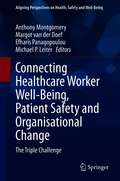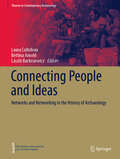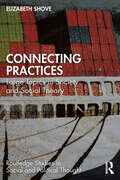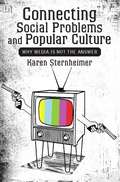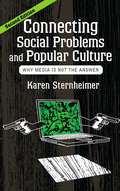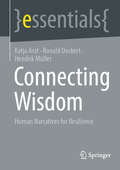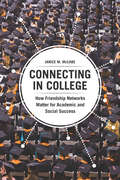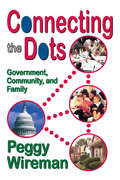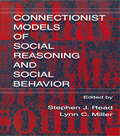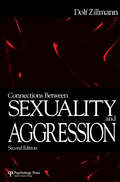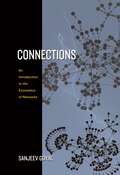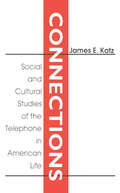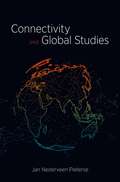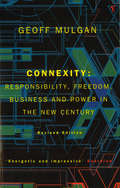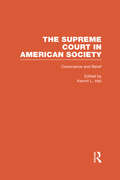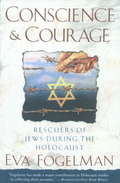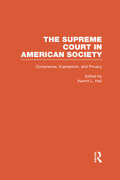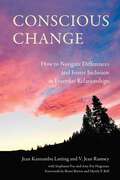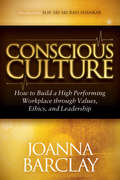- Table View
- List View
Connecting Healthcare Worker Well-Being, Patient Safety and Organisational Change: The Triple Challenge (Aligning Perspectives on Health, Safety and Well-Being)
by Michael P. Leiter Anthony Montgomery Efharis Panagopoulou Margot van der DoefThis volume delineates the ways in which key areas of healthcare, well-being, patient safety and organisational change overlap with and contribute to unhealthy workplaces for healthcare professionals. There is a growing realisation within healthcare that healthcare worker well-being, patient outcomes and organisational change are symbiotically linked. Burnout and stress in healthcare workers and toxic organisational cultures can lead to a cycle of patient neglect, medical errors, sub-optimal care and further stress. This topical volume therefore outlines the ways in which worker well-being, patient outcomes and organisational change can be aligned to contribute to a healthy workplace and therefore better medical care. The volume includes an array of authors from different disciplines including primary care, clinical medicine, psychology, sociology, management, clinical governance, health policy and health services research. It succeeds in integrating different voices and reaches meaningful conclusions to address the challenges facing the healthcare workforce.
Connecting People and Ideas: Networks and Networking in the History of Archaeology (Themes in Contemporary Archaeology)
by László Bartosiewicz Bettina Arnold Laura ColtofeanThis book presents new research into social networks and the various networking modes that formed during the history of archaeology in distinct geographical settings in Europe, North America, and South Asia in the nineteenth and twentieth centuries. The diverse range of international experts in this edited collection demonstrate that networks can be found everywhere in archaeology, making it a highly interconnected research field. Using a wide array of examples from diverse geopolitical, cultural, and social contexts, the volume reveals how essential social networks and networking have been to the development of archaeology; to the production, transfer, exchange, and dissemination of archaeological and cross-disciplinary knowledge; and to the formation, upward mobility, barrier transcendence, research, and association of archaeological practitioners. The book is of interest to students and scholars of history of archaeology, history of science, museum studies and interdisciplinary studies.
Connecting Practices: Large Topics in Society and Social Theory (Routledge Studies in Social and Political Thought)
by Elizabeth ShoveConnecting Practices develops a distinctive method of conceptualising significant trends and global issues including environmental sustainability and inequalities in wealth and health, arguing that these are outcomes of the ways in which social practices interact and combine across space and time. Engaging with the question of how connections are made between practices and how past and present combinations make some futures more likely than others, this book brings practice theory to bear on large problems in society. Richly illustrated with examples from the spreading of germs to the history of shipping containers, this powerful analysis of how societies hang together and how they change will appeal to scholars and students of sociology and social theory.
Connecting Social Problems and Popular Culture
by Karen SternheimerWhile popular culture receives a lot of attention as a central causal factor in contemporary social problems, Sternheimer (sociology, U. of Southern California) argues that in reality, although media does impact society, there are many more important factors contributing to America's serious social problems today. The author examines the history of media fears, who constructs media--and youth--phobia and why, and then analyzes a number of social problems--the dumbing down of America, family instability, violence, teen sex, teen pregnancy and single parenthood, the rising materialism of youth, eating disorders, substance abuse, misogyny, homophobia, and racism--and their causes. Annotation ©2009 Book News, Inc. , Portland, OR (booknews. com)
Connecting Social Problems and Popular Culture
by Karen SternheimerIs violence on the streets caused by violence in video games? Do hip-hop lyrics increase misogynistic and homophobic behavior? Are teens promiscuous because of what they see in movies? Popular culture is an easy answer for many of society's problems, but it is almost always the wrong answer. This innovative book goes beyond the news-grabbing headlines claiming that popular culture is public enemy number one to consider what really causes the social problems we are most concerned about. The sobering fact is that the roots of poverty, child abuse, and unequal public education are much more complicated than the media-made-them-do-it explanations. Karen Sternheimer deftly illustrates how welfare "reform," a two-tiered health care system, and other difficult systemic issues have far more to do with our contemporary social problems than Grand Theft Auto or 50 Cent.
Connecting Social Problems and Popular Culture
by Karen SternheimerIs violence on the streets caused by violence in video games? Do hip-hop lyrics increase misogynistic and homophobic behavior? Are teens promiscuous because of what they see in movies? Popular culture is an easy answer for many of society's problems, but it is almost always the wrong answer. This innovative book goes beyond the news-grabbing headlines claiming that popular culture is public enemy number one to consider what really causes the social problems we are most concerned about. The sobering fact is that the roots of poverty, child abuse, and unequal public education are much more complicated than the media-made-them-do-it explanations. Karen Sternheimer deftly illustrates how welfare "reform," a two-tiered health care system, and other difficult systemic issues have far more to do with our contemporary social problems than Grand Theft Auto or 50 Cent.
Connecting Social Problems and Popular Culture
by Karen SternheimerIs violence on the streets caused by violence in video games? Does cyber-bullying lead to an increase in suicide rates? Are teens promiscuous because of Teen Mom? As Karen Sternheimer clearly demonstrates, popular culture is an easy scapegoat for many of society’s problems, but it is almost always the wrong answer. Now in its second edition, Connecting Social Problems and Popular Culture goes beyond the news-grabbing headlines claiming that popular culture is public enemy number one to consider what really causes the social problems we are most concerned about. The sobering fact is that a "media made them do it" explanation fails to illuminate the roots of social problems like poverty, violence, and environmental degradation. Sternheimer’s analysis deftly illustrates how welfare "reform," a two-tiered health care system, and other difficult systemic issues have far more to do with our contemporary social problems than Grand Theft Auto or Facebook. The fully-revised new edition features recent moral panics--think sexting and cyberbullying--and an entirely new chapter exploring social media. Expanded discussion of how we understand society’s problems as social constructions without disregarding empirical evidence, as well as the cultural and structural issues underlying those ills, allows students to stretch their sociological imaginations.
Connecting Social Problems and Popular Culture
by Karen SternheimerIs violence on the streets caused by violence in video games? Does cyber-bullying lead to an increase in suicide rates? Are teens promiscuous because of Teen Mom? As Karen Sternheimer clearly demonstrates, popular culture is an easy scapegoat for many of society's problems, but it is almost always the wrong answer.Now in its second edition, this innovative book goes beyond the news-grabbing headlines claiming that popular culture is public enemy number one to consider what really causes the social problems we are most concerned about. The sobering fact is that a "media made them do it" explanation fails to illuminate the roots of social problems like poverty, violence, and environmental degradation. Sternheimer's analysis deftly illustrates how welfare "reform," a two-tiered health care system, and other difficult systemic issues have far more to do with our contemporary social problems than Grand Theft Auto or Facebook. The fully-revised new edition features recent moral panics-think sexting and cyberbullying-and an entirely new chapter exploring social media. Expanded discussion of how we understand society's problems as social constructions without disregarding empirical evidence, as well as the cultural and structural issues underlying those ills, allows students to stretch their sociological imaginations.
Connecting Wisdom: Human Narratives for Resilience (essentials)
by Ronald Deckert Hendrik Müller Katja ArztWe paint a comprehensive picture of human wisdom and networking, striving for a holistic understanding of resilience. To make this perspective tangible, we use narratives. These narratives encompass scientific categories of the Anthropocene, ancient stories from antiquity, and deeply personal insights. We believe that the connections of humans with nature as well as with our inner selves will be crucial to develop forward-looking attitudes. Our perception of the world determines what we see, feel, and the actions we undertake. By using legends, fairy tales, and stories of sustainability and resilience, we aim to reconnect us. The essence of wisdom lies in the courage to write our own individual narratives as a contribution to the broader picture and to listen to each other with open hearts.
Connecting in College: How Friendship Networks Matter for Academic and Social Success
by Janice M. MccabeWe all know that good study habits, supportive parents, and engaged instructors are all keys to getting good grades in college. But as Janice M. McCabe shows in this illuminating study, there is one crucial factor determining a student's academic success that most of us tend to overlook: who they hang out with. Surveying a range of different kinds of college friendships, Connecting in College details the fascinatingly complex ways students' social and academic lives intertwine and how students attempt to balance the two in their pursuit of straight As, good times, or both. As McCabe and the students she talks to show, the friendships we forge in college are deeply meaningful, more meaningful than we often give them credit for. They can also vary widely. Some students have only one tight-knit group, others move between several, and still others seem to meet someone new every day. Some students separate their social and academic lives, while others rely on friendships to help them do better in their coursework. McCabe explores how these dynamics lead to different outcomes and how they both influence and are influenced by larger factors such as social and racial inequality. She then looks toward the future and how college friendships affect early adulthood, ultimately drawing her findings into a set of concrete solutions to improve student experiences and better guarantee success in college and beyond.
Connecting the Dots: Government, Community, and Family
by Peggy WiremanDespite its size and social diversity, the United States is one nation, and what happens in one city or neighborhood ultimately affects all Americans. "Connecting the Dots" addresses the complex relationships between family and community, and between community and other players affecting family and community life, including the private sector, government, nonprofit groups, and religious organizations. Contrary to much rhetoric, Wireman argues that America does not suffer from a loss of family values, but from a shift in business practices and public commitments. The American dream of work hard, buy a home, and give your children a better life is no longer realistic for millions of workers, both white-collar and blue-collar. At an individual level, millions of Americans face significant challenges as they go about trying to meet the everyday responsibilities of earning an income, feeding their families, maintaining their health, finding housing, handling everyday household chores, and caring for their children. Besides identifying top-down structures, laws, and attitudes that create a supportive context for family life, the book includes bottom-up anecdotal examples to ground its policy-oriented discussion. It also provides statistical data needed to develop realistic solutions. Wireman examines diversity as well, since how America handles racial and ethnic differences remains crucial to its future. She discusses ways in which communities have created social capital, community cohesion, and local organizational ability. Wireman provides a framework for policymakers, local community leaders, and neighborhood activists to use in analyzing their situations and selecting the best approach; she also describes what various players can and must do to uphold the American dream. "Connecting the Dots" will be of keen interest to sociologists, political scientists, economists, and social workers.
Connectionist Models of Social Reasoning and Social Behavior
by Lynn C. Miller Stephen J. ReadAlthough neural network models have had a dramatic impact on the cognitive and brain sciences, social psychology has remained largely unaffected by this intellectual explosion. The first to apply neural network models to social phenomena, this book includes chapters by nearly all of the individuals currently working in this area. Bringing these various approaches together in one place, it allows readers to appreciate the breadth of these approaches, as well as the theoretical commonality of many of these models. The contributors address a number of central issues in social psychology and show how these kinds of models provide insight into many classic issues. Many chapters hint that this approach provides the seeds of a theoretical integration that the field has lacked. Each chapter discusses an explicit connectionist model of a central problem in social psychology. Since many of the contributors either use a standard architecture or provide a computer program, interested readers, with a little work, should be able to implement their own variations of models. Chapters are devoted to the following topics and models: * the learning and application of social categories and stereotypes; * causal reasoning, social explanation, and person perception; * personality and social behavior; * classic dissonance phenomena; and * belief change and the coherence of large scale belief systems.
Connections Between Sexuality and Aggression
by Dolf ZillmannThis is the only available comprehensive monograph on interrelations and interdependencies between agonistic and sexual behaviors. Integrating theory and research from biology, anthropology, neurophysiology, endocrinology, psychophysiology, and psychology, this book focuses on the mechanisms that govern the mutual influences between sexuality and aggression in behavior sequences and especially in admixtures of aggressive-sexual behaviors. This book places human agonistic and sexual behaviors into an evolutionary context. It offers a Weltbild of human aggressive-sexual behaviors by tracing their biological and developmental origins and examines the plasticity and manipulability of connections between agonistic and sexual behaviors. Strategies for the maximization of sexual pleasures are elaborated , and intervention treatments--aiming at the control of violent behaviors--are considered. Coercive sexuality is given special attention. Prevalent motive ascriptions to rape are called into question and the motivation that dominates rape is reinterpreted in the context of pleasure maximization. This second edition brings the coverage of pertinent research up to date. It advances the exploration of aggressive-sexual behaviors by further integrating the research contributions from various disciplines, and by refining and unifying theory capable of explaining the behavioral phenomena under consideration. COPY FOR ZILLMANN MAILER Zillmann examines issues such as sexual access through aggression, the involvement of agonistic behavior within sexuality, sex-aggression fusion, the consequences of anticipatory imagination concerning sexuality, and aspects of libido loss due to excitatory habituation. This book also: * traces connection between sexuality and aggression in nonhuman species, especially in nonhuman primates, * subjects human behavior to comparative and evolutionary analysis, * examines connectedness in neurological and endocrinological terms, * details both central and autonomic commonalities between sexual and aggressive behaviors, * outlines sexual dimorphism and chromosomal-endocrine aberrations, * pays special attention to adrenal commonalities in sexual and aggressive behaviors and the fusion of these behaviors, and * examines aggressive-sexual connectedness in the analysis of motivation and emotion. Zillmann finally proposes new explanations for the numerous documented associations between sexuality and aggression. These proposals combine biological, neuroendocrine, autonomic, and cognitive aspects of aggressive and sexual behaviors. A trichotomy of excitatory interdependencies is developed for fight, flight, and coition. In the nomenclature of emotion, this trichotomy concerns the interdependencies between aggressiveness, fear, and sexual impulsion. A considerable amount of research evidence is aggregated in support of these interdependencies. The author ultimately examines the exploitation of the existing connections between sexual and aggressive behaviors, especially the exploitation that serves the enhancement of sexual pleasure. In this context he arrives at novel, and perhaps distressing, characterizations of sexual coercion. However, he also explores sexual boredom and discusses remedies in the framework of his theorizing. Last but not least, sexual aggression, and sexual and aggressive behaviors independently, are placed into an evolutionary context. Recognition and acknowledgment of the archaic nature of many aspects of sexual and aggressive behaviors, in contrast to the comparatively vernal development of behavior-guiding contemplation, leads him to a unique and provocative proposal of the function of aggression in the realm of sexuality.
Connections: An Introduction to the Economics of Networks
by Sanjeev GoyalNetworks pervade social and economic life, and they play a prominent role in explaining a huge variety of social and economic phenomena. Standard economic theory did not give much credit to the role of networks until the early 1990s, but since then the study of the theory of networks has blossomed. At the heart of this research is the idea that the pattern of connections between individual rational agents shapes their actions and determines their rewards. The importance of connections has in turn motivated the study of the very processes by which networks are formed. In Connections, Sanjeev Goyal puts contemporary thinking about networks and economic activity into context. He develops a general framework within which this body of research can be located. In the first part of the book he demonstrates that location in a network has significant effects on individual rewards and that, given this, it is natural that individuals will seek to form connections to move the network in their favor. This idea motivates the second part of the book, which develops a general theory of network formation founded on individual incentives. Goyal assesses the robustness of current research findings and identifies the substantive open questions. Written in a style that combines simple examples with formal models and complete mathematical proofs, Connections is a concise and self-contained treatment of the economic theory of networks, one that should become the natural source of reference for graduate students in economics and related disciplines.
Connections: Social and Cultural Studies of the Telephone in American Life
by James E. KatzPerhaps no other technology has done so much to so many, but been studied by so few, as the telephone. Even as its physical size diminishes, the telephone is becoming more important. In Connections, now available in paperback, James E. Katz gives greater visibility to this important element in modern life.Katz examines how the telephone reveals gender relations in a way not predicted by feminist theories, how it can be used to protect and invade personal privacy, and how people harness telephone answering machines to their advantage. Katz's inquiry reports on obscene phone calls, the abuses of caller-ID technology, and attitudes toward voice mail. National data about cellular telephones are presented to show the extent to which beepers and car phones have become status symbols.Katz ranges from microsocial interaction to macrosocial theory, and from the family and personal levels of organization to that of large-scale industrial bureaucracies. The result of this investigation is a compelling mosaic spanning sociology and psychology, and organization and communication studies. These arresting portraits will offer profound insight to historians, students of American culture, and those concerned about the nature and direction of the emerging information society.
Connectivity and Global Studies
by Jan Nederveen PieterseThis textbook provides readers with evocative and analytical accounts of social processes that are linked to globalization and connectivity, which includes a wide range of multi-centred connections in history, DNA analysis, technology, art, populism and political economy. Rather than globalization, Nederveen Pieterse focuses on connectivity. His approach to globalization differs from both structuralist accounts of the world-system, and the institutionally-centred focus of much work in international studies. This synthesis will provide a new resource to reconstruct theoretical approaches to globalization and global studies. Fluently written, clearly organized and with an interdisciplinary approach, the book will be accessible to upper division undergraduates and graduates in social sciences, including students and researchers from the fields of sociology, politics, political economy, development studies and international relations.
Connexity: How to Live in a Connected World
by Geoff MulganCONNEXITY is the philosophical counterpart to Will Hutton's essentially political book. It looks at the profound tension that exists between two recent achievements of humanity: greater freedom (over how to live, who to love, what to believe and say, where to trade), and greater interdependence, or 'connexity' (through the financial markets, military structures, the internet, the ecosystem). This tension has led to crisis: institutions, including governments, sense themselves to be inadequate; individuals are faced with a mass of conflicting information and values. The issue we face, which will ultimately determine human survival in our densely packed planet, is how the tension between these two can be resolved, and a new order established. Mulgan presents his own powerful solution to this crisis. It is based around the notion of 'connexity': breaking down our rigid sense of ourselves as isolated units and seeing our lives as part of a system, a positive network of co-responsibility.
Conquests and Cultures: An International History
by Thomas SowellThis book is the culmination of 15 years of research and travels that have taken the author completely around the world twice, as well as on other travels in the Mediterranean, the Baltic, and around the Pacific rim. Its purpose has been to try to understand the role of cultural differences within nations and between nations, today and over centuries of history, in shaping the economic and social fates of peoples and of whole civilizations. Focusing on four major cultural areas(that of the British, the Africans (including the African diaspora), the Slavs of Eastern Europe, and the indigenous peoples of the Western Hemisphere -- Conquests and Cultures reveals patterns that encompass not only these peoples but others and help explain the role of cultural evolution in economic, social, and political development.
Consanguinity in Context
by Alan H. BittlesAn essential guide to this major contemporary issue, Consanguinity in Context is a uniquely comprehensive account of intra-familial marriage. Detailed information on past and present religious, social and legal practices and prohibitions is presented as a backdrop to the preferences and beliefs of the 1100+ million people in consanguineous unions. Chapters on population genetics, and the role of consanguinity in reproductive behaviour and genetic variation, set the scene for critical analyses of the influence of consanguinity on health in the early years of life. The discussion on consanguinity and disorders of adulthood is the first review of its kind and is particularly relevant given the ageing of the global population. Incest is treated as a separate issue, with historical and present-day examples examined. The final three chapters deal in detail with practical issues, including genetic testing, education and counselling, national and international legislation and imperatives, and the future of consanguineous marriage worldwide.
Conscience and Belief: The Supreme Court in American Society (The\supreme Court In American Society Ser. #Vol. 8)
by Kermit L. HallAvailable as a single volume or as part of the 10 volume set Supreme Court in American Society
Conscience and Courage: Rescuers of Jews During the Holocaust
by Eva FogelmanIn this brilliantly researched and insightful book, psychologist Eva Fogelman presents compelling stories of rescuers of Jews during the Holocaust--and offers a revealing analysis of their motivations. Based on her extensive experience as a therapist treating Jewish survivors of the Holocaust and those who helped them, Fogelman delves into the psychology of altruism, illuminating why these rescuers chose to act while others simply stood by. While analyzing motivations, Conscience And Courage tells the stories of such little-known individuals as Stefnaia Podgorska Burzminska, a Polish teenager who hid thirteen Jews in her home; Alexander Roslan, a dealer in the black market who kept uprooting his family to shelter three Jewish children in his care, as well as more heralded individuals such as Oskar Schindler, Raoul Wallenberg, and Miep Gies. Speaking to the same audience that flocked to Steven Spielberg's Academy Award-winning movie, Schindler's List, Conscience And Courage is the first book to go beyond the stories to answer the question: Why did they help?From the Trade Paperback edition.
Conscience, Expression, and Privacy: The Supreme Court in American Society (The\supreme Court In American Society Ser. #Vol. 9)
by Kermit L. HallAvailable as a single volume or as part of the 10 volume set Supreme Court in American Society
Conscious Change: How to Navigate Differences and Foster Inclusion in Everyday Relationships
by Jean Kantambu Latting V. Jean RamseyEvery day, most of us interact with people of disparate backgrounds, beliefs, and experiences—individuals who hold different expectations than we do of the people and world around them. How does one navigate these often-turbulent waters?In Conscious Change, nineteen authors describe how they have applied the principles of Conscious Change within multicultural, diverse environments to overcome difficult and emotionally draining challenges—and, in doing so, provide a road map to shifting one&’s own story when moving through similarly demanding situations in all areas of life. These practical case studies reveal how transformational the Conscious Change tools can be, leading to a stronger sense of one&’s personal capacity as a leader, better interpersonal relationships, and the beginnings of greater equity and inclusion. Illuminating and instructive, these stories are vivid illustrations of the skills today&’s leaders need in their multicultural organizations and settings, where issues of diversity, equity, and inclusion are, and will increasingly be, front and center.
Conscious Coastal Cities: Sustainability, Blue Green Growth, and The Politics of Imagination
by Voula P. MegaIn the age of urban geopolitics, in cooperation with the major city networks and initiatives, interconnected coastal cities lead towards a more resilient sustainable future. This book raises global awareness on the challenges and opportunities for coastal cities and the myriad of issues and stakeholders which impact them. The book offers a panoramic integrated view of the most critical urban coastal sustainability issues shaping the urban horizon of the future. Drawing on the most authoritative studies and asking further questions, the book embraces issues of smart, sustainable and inclusive blue green growth, active social integration, environmental conscience and resilience, food, energy and resource security, exploration and protection of the global ocean, ecosystem-based urban coastal planning and policy and progress in education and science, culture and the arts, coastal urban renaissance and accountable multi-layered governance. From large global ports to small tourism and fishing resorts, sustainable development calls for coastal cities to improve their functions. Coastal cities need to adopt ecosystem-based approaches to manage the land-sea continuum, invest in blue green energy and mobility, attract responsible business investment, and honour the sea as a source of infinite innovation and culture.
Conscious Culture: How to Build a High Performing Workplace through Values, Ethics, and Leadership
by Joanna BarclayWith employee engagement between 26-30 percent leaders are looking for ways to engage untapped employee potential and maximize their capital investment in HR. A new business paradigm is emerging in the twenty-first century where an organization's culture is the most important and valuable asset a company has to attract, engage, and retain top talent. The most successful corporations in the world are values-driven and consciously invest in building their workplace culture so that it aligns with the personal values of their people. Values are a source of life-force energy that come from within. They inspire and motivate us and embody our heart and soul. Study of contextual cardiology has demonstrated the existence and power of the heart's energy. We experience this in the form of emotional intelligence and intuition. The more leaders practice connecting with their emotional intelligence (emotions such as love, compassion, loyalty, and trust), the more effective they will be at leading themselves and others. This is because employees are looking for leaders they can trust and who care for others, want to make a difference, and contribute to society. A facilitative leadership style is the key to transforming an organization and creating a culture of engagement. It moves people from being focused on "me" (self-interest) to "we" (common good). Facilitative leaders unify the organization, connect hearts and minds, empower employees to bring their best selves to work, and create a WOW culture where employees love what they do. The book contains unique tools for inner and outer transformation, along with case studies and worksheets to support leaders' journeys of culture change to measure, map, and manage cultural transformation. What you measure you can manage. Organizational transformation begins with the personal transformation of the leaders because organizations don't change; it's the people in them who do. Leaders learn how to "walk the talk" and be the change they want to see.
